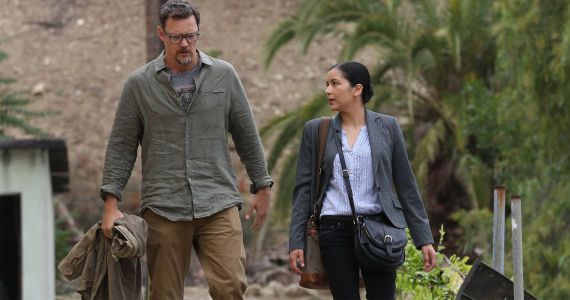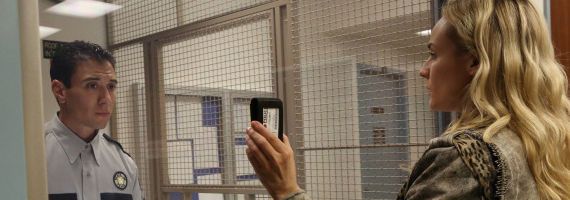Last week's episode, 'The Beast,' was a solid piece of television that excelled at taking the smaller moments, which have so far been the lifeblood of The Bridge, and expertly combining them with the larger driving force behind the series. Suddenly, the characters – even newly introduced ones like Gina Meadows or Fausto Galván – and their world felt alive and connected because of, rather than in spite of, their mingling. (However, I'm withholding judgment on His Royal Broness, Brian Van Holt, until after Lyle Lovett has completed a satisfactory background check.)
Many people seemed to fixate on the likelihood that someone like Galván wouldn't know what a serial killer was, especially when that someone was a man for whom death is part and parcel with his business, whether he liked it or not. And in doing so, they missed out on an incredibly well-written and acted scene between Galván and his associate about the purpose behind killing another human being. It shed some much-needed light on a character heretofore known through secondhand accounts of the few who would dare speak his name.
But instead of painting Fausto as some kind of monster with Voldemort-like status, 'The Beast' chose to inform on the cartel leader by presenting a better understanding of what a day in his life is like. (Hint: It's not very pleasant.) In that regard, Fausto became a full-fledged being and member of The Bridge's Colorful Character Crew – a group of folks not named Sonya or Marco, but who exhibit a level of development and personality only reserved for secondary characters on great TV shows.
Galván, like the killer (or La Bestia/The Bridge Butcher, if they are, in fact, the same person), is a purveyor of violence; it may not be pleasurable, but its certainly is his business. Unlike the killer, however, Galván's enterprise works best where his character used to be: in the shadows and dark places left unexamined or otherwise ignored for fear of what might be uncovered. He resides behind power and fear, the kind that comes from doing things like impaling Calaca's dead body on a telephone pole in the middle of Juárez and suppressing an investigation into the murder of his brother.
Galván's message is a potent mixture of product and theatricality that no one is ever to be caught speaking of or asking questions about. And while the killer is intent on making a larger political statement through his own brutal and gruesome acts of theatricality, he and Galván both value the silence of their intended audience enough (people like Charlotte Millwright, who have glimpsed into the dark cavernous recesses of the world literally running underneath their own, but would rather carry on as though they hadn't) that quieting them becomes a part of the overall message.
In that regard, the episode examines a series of messages intended to impart the importance and virtue of silence and anonymity at a time when the dissemination of information and the identification of those involved is most crucial.
At the moment, vital information remains locked away, either in the mind of a frightened and traumatized Gina Meadows, the permanently scrambled brain of Jim Dobbs, or, as Adriana and Daniel discover, it's deliberately kept hidden for fear of reprisal. And while Charlotte and her Tampa-bred boy toy become the poster children for the same willful ignorance the killer remarked runs rampant in institutions like the FBI, it's Gina who finds herself another innocent victim of an institution too wrapped up in its own dealings to be mindful of what she's doing.
In the end, the only one truly watching over Gina was the one responsible for taking her life. And as a result, the Beast reveals something about himself: he's patient, observant and is afraid enough of getting caught that he's willing to kill a witness in broad daylight while two detectives are in the immediate vicinity. And in her dying words, Gina tells Sonya that she got the killer's eyes right, but the rest of his face remains obscured, adding the Beast to a list of killers fighting to remain faceless to those pursuing them, while the memory of their victims – whether they be rows of pink crosses or crude doodles in crayon – beg for recognition.
At its heart, 'ID' ponders the ramifications of seeking and gaining knowledge through the act of looking and seeing. Perhaps, as the killer puts it, the U.S. turns a blind eye to its neighbor because the reality and the responsibility are too unsavory a thing to look directly in the face. Is it any wonder, then, that so many characters are doing the same?
_____
The Bridge continues next Wednesday with 'Destino' @10pm on FX.



